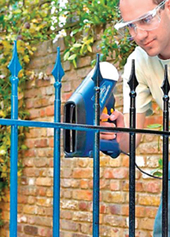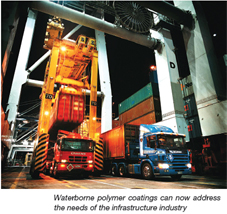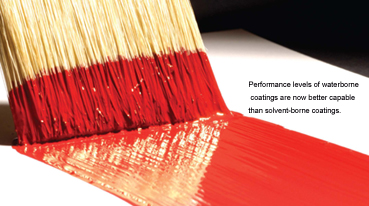KTP Radhika Jinoy

Taking a turn towards environment-friendliness and sustainability, the new age waterborne polymer coatings are playing an important role in the infrastructure industry. These protective coatings extend the life of expensive assets; have excellent abrasion and mar resistance; and reduce the risk of dangerous structural failures. Waterborne polymer paints boast of a long and successful history in industrial applications. From a simple house-building site to heavy industrial applications, waterborne polymer coatings (WPC) meet a variety of purposes. The term "waterborne" refers to coating system that primarily uses water as the solvent to disperse the resin.

Evolution of WPC The history of waterborne polymer paints for industrial applications dates back to the 1950s. In 1957, chemists succeeded in industrially manufacturing the first powder binder as an additive for construction mortars. In the same year, the first spray dryer for dispersible polymer powders was found. Since then, industrialists have started manufacturing dispersible polymer powders to meet emerging construction needs. This invention revolutionised the entire construction sector. It finally made possible the production of one-part, pre-mixed dry mortars that merely needed reconstituting with water at the building site. Prior to this, polymer-binders were available only in the form of dispersions which had to be mixed with the mortar in the proportions given in the recipe. With the invention of dispersible polymer powders, the manufacturer could mix ingredients in advance. Polymer powders give the construction industry some key benefits like cost savings, simplified mortar production and handling, among others. The 1980s saw major changes and innovations in paints and coatings industry. This was the period when waterborne acrylic resin technology gained considerable acceptance in the coatings industry. Acrylic resins are a group of thermoplastic or thermosetting plastic substances derived from acrylic acid, methacrylic acid or other related compounds.

Technology has evolved rapidly over the last 10 years producing waterborne polymer coatings that can address the needs of the infrastructure industry. Latex polymers (acrylic and vinyl acetate-acrylic) made by emulsion polymerisation helped in the transformation of solvent-borne system to waterborne one. Besides, the evolution of waterborne polymer coatings has been driven largely by consumer preference for low-odour, water cleanup and fast (dry) re-coat of waterborne systems. Advancements in thickener technology have also supported many of these changes. Further, the long-term exterior performance of acrylic systems have led to their growth as these are easier to manufacture and can be cleaned easily. Moreover, the performance levels of these coatings depend on a thorough understanding of the formulating variables. "The continuous shift from solvent-borne systems to waterborne and powder coatings suggests that environment considerations play an important role in shaping this industry" Many shades of polymers Today, companies have invented new technologies to improve the quality of waterborne polymer coatings so that they help meet the needs of the infrastructure industry. For instance, Dow Coating Materials recently introduced technologically-innovative and environmentally-advanced acrylic polymers as an alternative to conventional alkyd polymers. Dow's Fastrack technology for water-based road marking paint was such an invention. This paint bears characteristics like good weathering-and-wearing resistance; improved adhesion with glass beads besides offering good visibility in the night. These characteristics make it best-suited for road projects. Defoaming effect: Another example in this context is the Foamst
adidas Laufschuhe und Laufbekleidung kaufen Taking a turn towards environment-friendliness and sustainability, the new age waterborne polymer coatings are playing an important role in the infrastructure industry. These protective coatings extend the life of expensive assets; have excellent abrasion and mar resistance; and reduce the risk of dangerous structural failures. Waterborne polymer paints boast of a long and successful history in industrial applications. From a simple house-building site to heavy industrial applications, waterborne polymer coatings (WPC) meet a variety of purposes. The term "waterborne" refers to coating system that primarily uses water as the solvent to disperse the resin.
Taking a turn towards environment-friendliness and sustainability, the new age waterborne polymer coatings are playing an important role in the infrastructure industry. These protective coatings extend the life of expensive assets; have excellent abrasion and mar resistance; and reduce the risk of dangerous structural failures. Waterborne polymer paints boast of a long and successful history in industrial applications. From a simple house-building site to heavy industrial applications, waterborne polymer coatings (WPC) meet a variety of purposes. The term "waterborne" refers to coating system that primarily uses water as the solvent to disperse the resin.  Evolution of WPC The history of waterborne polymer paints for industrial applications dates back to the 1950s. In 1957, chemists succeeded in industrially manufacturing the first powder binder as an additive for construction mortars. In the same year, the first spray dryer for dispersible polymer powders was found. Since then, industrialists have started manufacturing dispersible polymer powders to meet emerging construction needs. This invention revolutionised the entire construction sector. It finally made possible the production of one-part, pre-mixed dry mortars that merely needed reconstituting with water at the building site. Prior to this, polymer-binders were available only in the form of dispersions which had to be mixed with the mortar in the proportions given in the recipe. With the invention of dispersible polymer powders, the manufacturer could mix ingredients in advance. Polymer powders give the construction industry some key benefits like cost savings, simplified mortar production and handling, among others. The 1980s saw major changes and innovations in paints and coatings industry. This was the period when waterborne acrylic resin technology gained considerable acceptance in the coatings industry. Acrylic resins are a group of thermoplastic or thermosetting plastic substances derived from acrylic acid, methacrylic acid or other related compounds.
Evolution of WPC The history of waterborne polymer paints for industrial applications dates back to the 1950s. In 1957, chemists succeeded in industrially manufacturing the first powder binder as an additive for construction mortars. In the same year, the first spray dryer for dispersible polymer powders was found. Since then, industrialists have started manufacturing dispersible polymer powders to meet emerging construction needs. This invention revolutionised the entire construction sector. It finally made possible the production of one-part, pre-mixed dry mortars that merely needed reconstituting with water at the building site. Prior to this, polymer-binders were available only in the form of dispersions which had to be mixed with the mortar in the proportions given in the recipe. With the invention of dispersible polymer powders, the manufacturer could mix ingredients in advance. Polymer powders give the construction industry some key benefits like cost savings, simplified mortar production and handling, among others. The 1980s saw major changes and innovations in paints and coatings industry. This was the period when waterborne acrylic resin technology gained considerable acceptance in the coatings industry. Acrylic resins are a group of thermoplastic or thermosetting plastic substances derived from acrylic acid, methacrylic acid or other related compounds.  Technology has evolved rapidly over the last 10 years producing waterborne polymer coatings that can address the needs of the infrastructure industry. Latex polymers (acrylic and vinyl acetate-acrylic) made by emulsion polymerisation helped in the transformation of solvent-borne system to waterborne one. Besides, the evolution of waterborne polymer coatings has been driven largely by consumer preference for low-odour, water cleanup and fast (dry) re-coat of waterborne systems. Advancements in thickener technology have also supported many of these changes. Further, the long-term exterior performance of acrylic systems have led to their growth as these are easier to manufacture and can be cleaned easily. Moreover, the performance levels of these coatings depend on a thorough understanding of the formulating variables. "The continuous shift from solvent-borne systems to waterborne and powder coatings suggests that environment considerations play an important role in shaping this industry" Many shades of polymers Today, companies have invented new technologies to improve the quality of waterborne polymer coatings so that they help meet the needs of the infrastructure industry. For instance, Dow Coating Materials recently introduced technologically-innovative and environmentally-advanced acrylic polymers as an alternative to conventional alkyd polymers. Dow's Fastrack technology for water-based road marking paint was such an invention. This paint bears characteristics like good weathering-and-wearing resistance; improved adhesion with glass beads besides offering good visibility in the night. These characteristics make it best-suited for road projects. Defoaming effect: Another example in this context is the Foamstadidas Laufschuhe und Laufbekleidung kaufen
Technology has evolved rapidly over the last 10 years producing waterborne polymer coatings that can address the needs of the infrastructure industry. Latex polymers (acrylic and vinyl acetate-acrylic) made by emulsion polymerisation helped in the transformation of solvent-borne system to waterborne one. Besides, the evolution of waterborne polymer coatings has been driven largely by consumer preference for low-odour, water cleanup and fast (dry) re-coat of waterborne systems. Advancements in thickener technology have also supported many of these changes. Further, the long-term exterior performance of acrylic systems have led to their growth as these are easier to manufacture and can be cleaned easily. Moreover, the performance levels of these coatings depend on a thorough understanding of the formulating variables. "The continuous shift from solvent-borne systems to waterborne and powder coatings suggests that environment considerations play an important role in shaping this industry" Many shades of polymers Today, companies have invented new technologies to improve the quality of waterborne polymer coatings so that they help meet the needs of the infrastructure industry. For instance, Dow Coating Materials recently introduced technologically-innovative and environmentally-advanced acrylic polymers as an alternative to conventional alkyd polymers. Dow's Fastrack technology for water-based road marking paint was such an invention. This paint bears characteristics like good weathering-and-wearing resistance; improved adhesion with glass beads besides offering good visibility in the night. These characteristics make it best-suited for road projects. Defoaming effect: Another example in this context is the Foamstadidas Laufschuhe und Laufbekleidung kaufen
 iConnectHub
iConnectHub
 Login/Register
Login/Register Supplier Login
Supplier Login


























